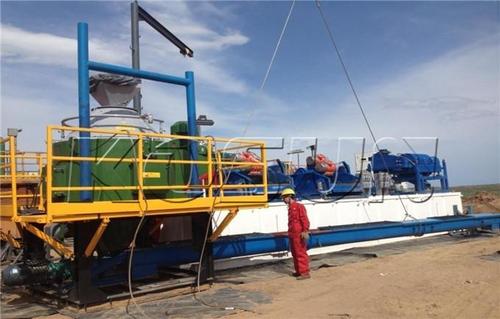- Home
- Products
-
-
Solids Control Equipment
- Linear Motion Shale Shaker
- Decanter Centrifuge
- Mud Cleaner
- Vacuum Degasser
- Centrifugal Pump
- Shear Pump
- Submersible Slurry Pump
- Mud Agitator
- Mud Gun
- Jet Mud Mixer
- Desilter
- Water Tank
- LS606 Shale Shaker
- Mud Tank
- LS1850 Shale Shaker
- Diesel Tank
- Dome-shaped mud cleaner
- Vertical cyclone desilter
- KQG30 Automatic Tank Cleaning
- MD210 Drilling Mud Cleaner
-
Solids Control System
- Solids Control System
- Mobile Solids Control System
- Arctic Solids Control System
- Drilling Mud Cooling System
- Liquid Mud Plant (LMP )
-
TBM
- Tunnel Boring Mud System
-
HDD
- HDD Mud Recovery System
-
-
- News
- Services
- Marketing
- About Us
- Contact Us
- Videos
Home > KOSUN News >
A Comprehensive Guide to Responsible Drilling Waste Disposal Methods
Jan 24, 2025
Responsible disposal of drilling waste is crucial to protect the environment, ensure regulatory compliance, and maintain sustainable practices in industries such as oil and gas, mining, and construction. By adopting responsible drilling waste disposal methods, companies can minimize environmental impact, optimize operational efficiency, and uphold their commitment to environmental stewardship. In this article, we present a comprehensive guide to responsible drilling waste disposal methods, providing insights into effective techniques that promote sustainability and environmental protection.

1, Solids Control and Waste Minimization:
Implementing robust solids control equipment, including shale shakers, desanders, and decanter centrifuges, is a fundamental step in responsible drilling waste management. These systems efficiently separate and remove drill cuttings and solids from drilling fluids, enabling the recycling and reuse of clean drilling fluids. By reducing the volume of waste generated at the source, companies can minimize the need for disposal and associated environmental impact.
2, Recycling and Reuse:
Whenever possible, recycling and reuse should be prioritized as responsible drilling waste disposal methods. Properly treated drilling fluids and cuttings can often be recycled and reintroduced into drilling operations. Companies should invest in advanced treatment technologies, such as centrifuges and drying systems, that allow for the extraction of valuable components from drilling waste for reuse. This approach not only minimizes waste generation but also reduces the consumption of fresh resources.
3, Stabilization and Solidification:
For certain types of drilling waste, stabilization and solidification techniques can be employed. Stabilization involves adding chemical agents to immobilize contaminants and reduce their leachability, making the waste less harmful to the environment. Solidification, on the other hand, involves binding the waste materials with cement or other binding agents to create a solid matrix. These methods enhance waste stability and reduce the risk of contamination during disposal. However, it is important to ensure that the final solidified waste meets regulatory requirements and can be safely transported and stored.
4, Thermal Treatment:
Thermal treatment methods, such as incineration and thermal desorption, can be utilized for drilling waste with high organic content or hazardous constituents. These processes involve subjecting the waste to high temperatures, which can effectively destroy organic contaminants and reduce waste volume. However, thermal treatment should only be considered when it aligns with environmental regulations and emissions control measures are in place to minimize air pollution.
5, Authorized Waste Disposal Facilities:
For drilling waste that cannot be recycled, reused, or treated on-site, it is crucial to partner with authorized waste disposal facilities. These facilities have the necessary permits and infrastructure to handle and dispose of different types of drilling waste in compliance with environmental regulations. Proper documentation, including waste manifests and tracking, should be maintained to ensure transparency and accountability in the disposal process.
6, Environmental Monitoring and Reporting:
Companies should establish robust environmental monitoring programs to assess the impact of drilling waste disposal methods on surrounding ecosystems. This includes monitoring soil, water, and air quality to detect any potential contamination. Regular reporting on waste management practices, compliance with regulations, and environmental performance is essential to demonstrate accountability and transparency.
Responsible drilling waste disposal methods are vital to protect the environment, comply with regulations, and maintain sustainable practices in various industries. By implementing effective solids control, recycling and reuse, stabilization and solidification, thermal treatment when appropriate, and partnering with authorized waste disposal facilities, companies can ensure responsible management of drilling waste. Environmental monitoring and reporting further reinforce the commitment to transparency and sustainability. By adopting these practices, companies can contribute to a greener future while optimizing their operational efficiency.
Tags: drilling waste disposal, drilling waste disposal methods, Responsible disposal of drilling waste, suppliers, manufacturers, factory, wholesale, buy, price, quotation, bulk, for sale, companies, stock, cost.


